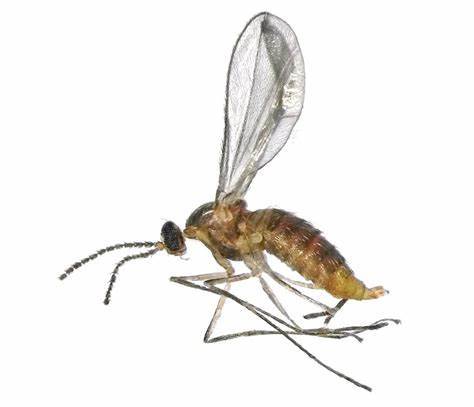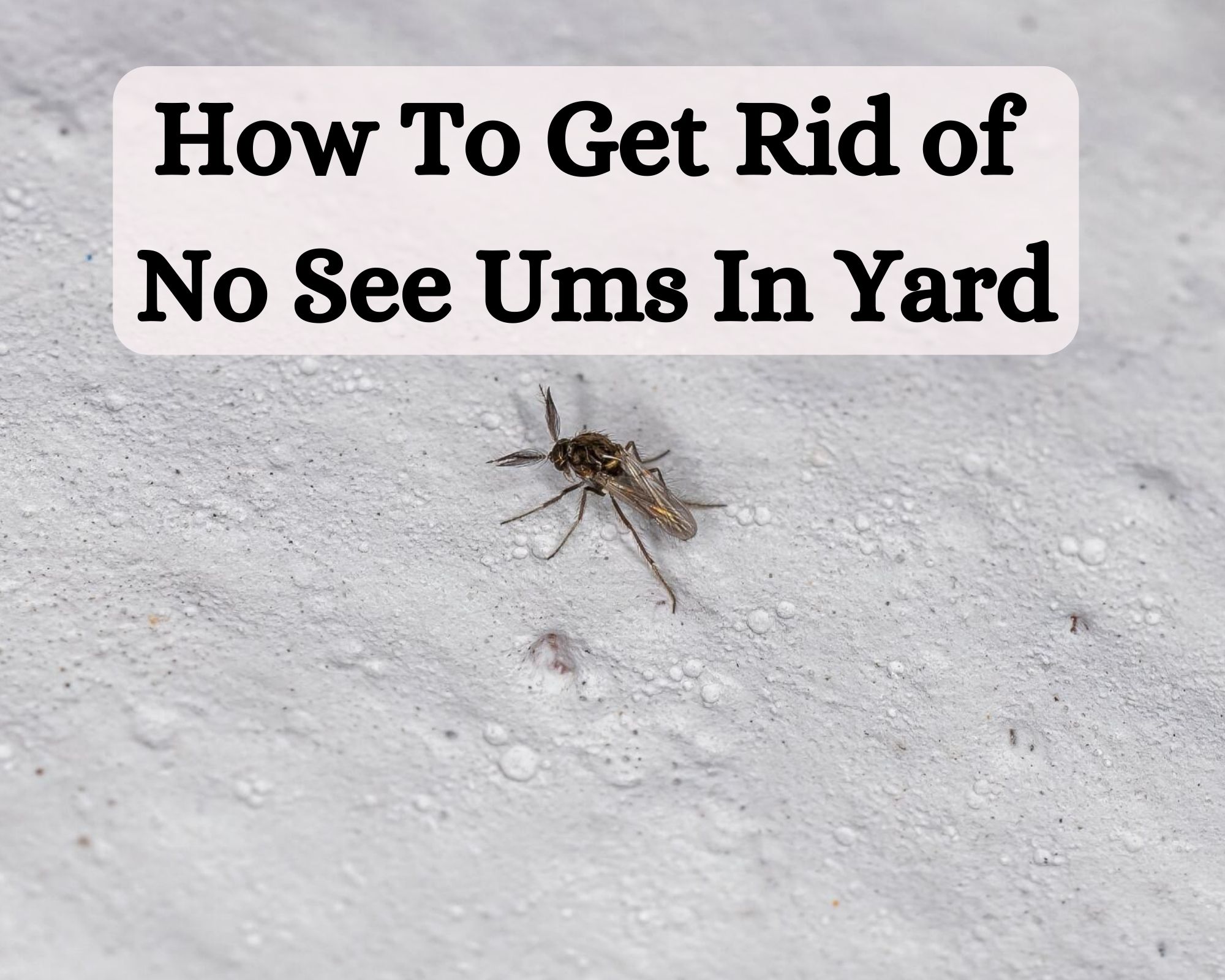True to their name, no-see-ums, also called biting midges or sandflies, are so tiny that they’re difficult to see. In fact, you may go about your business without realizing that you’ve been bitten until you begin to itch.
Having them in your outdoor living spaces is frustrating because they can easily disrupt your time outdoors. Fortunately, no-see-ums rarely venture indoors, so most of your efforts to eradicate them should be outdoors. But how do you tackle insects you can hardly see?
Below is a comprehensive guide on effectively getting rid of no-see-ums from your yard.
How To Get Rid of No See Ums In Yard
Prevention
Preventing no-see-ums is the best way to avoid dealing with these insects and enduring the painful, itchy bites. When it comes to these insects, their prevention looks a lot like mosquito prevention. The trick is to reduce hiding spots, breeding sites, and moisture.
a) Clean and Maintain Your Yard
No-see-ums love areas with dense vegetation and clutter, so a yard with tall grass, bushes, and brush is a prime location for these insects. Reduce hiding spots by cutting the grass short, regularly pruning bushes, shrubs, and trees, and removing weeds and fallen fruits.
Also, collect and take out yard waste like grass clippings and leaves to remove potential sheltering spots. Moreover, relocate or discard non-essential clutter, especially things that collect moisture, such as tree stumps, planters, and equipment.
Read More:
b) Remove Standing Water
No-see-ums breed in stagnant water, so regularly walk around your yard, especially in summer and spring, to identify areas where water accumulates. Empty any containers with water, such as flower pots, buckets, or children’s toys, and store them upside down or indoors when not in use to prevent water accumulation.
Additionally, clean the gutters and repair leaky faucets, hoses, pipes, drains, and sprinklers. Furthermore, level uneven ground to prevent water from pooling in low spots. Keep your swimming pool maintained and chlorinated if you have one.
c) Limit Outdoor Lighting
No-see-ums gravitate toward light, so limiting the amount of light in your home makes it less desirable for them. Install outdoor lights with dimmer switches so you can adjust the brightness levels. I also suggest trading bluish or white lights for yellow, orange, or pink-tinted bulbs for outdoor lighting.
Additionally, use motion-activated lights or turn off your outdoor lights when not in use rather than leaving outdoor lights on all night. Furthermore, close your blinds at night and position outdoor lights away from seating areas and entry points.
d) Shield Outdoor Living Spaces With Mesh Screens
You will enjoy your outdoor living spaces if you cover them with fine mesh screens to keep no-see-ums out. For instance, a permanent screen enclosure around your patio, porch, and even gazebo will provide a barrier against pests while allowing air to flow freely.
If you prefer a more flexible option, install retractable screens instead.
e) Install Fans Outdoors
No-see-ums are weak fliers, so airflow from fans can disrupt their flight patterns, making it hard for them to fly, hover, and land. Create a barrier of moving air by positioning fans strategically to protect your outdoor seating spots.
How To Kill No-See-Ums In Yard
a) Hang Gnat Ball Deluxe kit to get rid of No-See-Um
To effectively eliminate No-See-Ums using the Gnat Ball Deluxe kit, follow these steps:
Set Up: Hang the Gnat Ball trap in the infested area—ideally near breeding sites like damp areas or vegetation.
Attract and Trap: The Gnat Ball emits a lure that attracts No-See-Ums. Once near, the insects are captured in the sticky surface of the trap.
Monitor and Replace: Regularly check the trap and replace as needed. Dispose of trapped insects properly.
Repeat as Necessary: Continue using the Gnat Ball until the No-See-Um population decreases noticeably.
b) Set Up CO2 Traps
CO2 traps emit carbon dioxide, which attracts the no-see-ums to the trap where they are captured or killed. To increase its effectiveness, place the CO2 trap in areas where no-see-ums are known to be active, such as near vegetation, shady areas, or outdoor seating areas.
These traps are highly effective; unfortunately, they cost at least $300, so not everyone can afford them.
There’s a solution: save money by making your own trap. For instance, mix sugar, yeast, and hot water in a plastic container and put a funnel on top. The CO2 produced will lure the biting midges, who will then be trapped inside the liquid.
c) Use Insecticides
If a significant number of no-see-ums invade your yard, consider using insecticides to kill them. Purchase products formulated for target no-see-ums. These typically have ingredients like permethrin, pyrethroids, or carbamates.
Spray the entire yard, paying attention to dense vegetation, shrubbery, and other areas where these insects may hide. After the first application, repeat it in two weeks, then monthly after that. Spread granular insecticides to the soil in areas where no-see-um larvae are likely to breed, such as moist and shaded areas.
If the climate in your home is warm, spray insecticides once a month unless the temperatures go below freezing for a couple of weeks. On the other hand, start spraying every month towards the end of February and gradually decrease the frequency in November as you approach winter.
d) Trap With Vinegar and Soap
Create a vinegar and soap trap to attract and capture no-see-ums. The vinegar will lure them, while the soap traps and kills them.
Materials
- Shallow container
- White or apple cider vinegar
- Liquid dish soap
- Water
Directions
- Pour water, vinegar, and dish soap into the container, leaving some room to avoid an overflow when the no-see-ums drop inside. Gently stir the mixture.
- Position the trap near no-see-ums active areas.
- Regularly inspect the trap to see if there are any ensnared no-see-ums. Empty the trap and refill it with a fresh soap and vinegar solution.
How To Prevent No-See-Ums Bites
Before spending time in your yard, take precautions to keep yourself safe from no-see-ums bites. You would not want these insects biting you.
Despite their minuscule size, these insects deliver painful bites characterized by small, red, itchy welts on the skin. The itchy sensation can persist for several days.
i) Apply Repellent
Apply an insect repellent designed to deter no-see-ums on exposed skin, including arms, legs, neck, and face, but not eyes and mouth. Apply it to your clothing as well for added protection. Suitable choices are repellents with DEET in high doses or picaridin.
When using repellents on kids, choose a product with a low concentration of active ingredients and avoid applying it to their hands to prevent accidental ingestion. Wash off the repellent with soap and water once you are back indoors and the protection is no longer required.
If you are pregnant or have sensitive skin, opt for natural repellents like lemon eucalyptus oil and citronella. Mix essential oil with some carrier oil and rub it onto your skin, or use it in diffusers around your yard.
ii) Wear Protective Clothing
Another way of protecting yourself from biting midges is through protective clothing. Put on clothing that covers as much skin as possible, including long sleeves, long pants, socks, and closed-toe shoes.
Ensure your clothes are made of tightly woven materials like denim or synthetic fabrics because these insects can bite through thin fabrics. Also, choose loose-fitting clothing to create a barrier between your skin and the insects.
Furthermore, wear light-colored clothing because it is less attractive to no-see-ums than dark colors. If you are venturing to no-see-ums prevalent spots, tuck your pants into your socks.
iii) Avoid No-See-Ums Peak Activity Times
Biting midges are most active during dawn and dusk, as well as in the early morning and late afternoon. If you can steer clear of your yard during these times, do so. Plan yard activities for late morning or early afternoon.
iv) Spend Time In Screen Areas
When spending time in your yard, do so in places with screened-in structures such as screened porches, gazebos, or patio enclosures. Inspect and repair the screens to make sure they continue keeping no-see-ums out.
You can also add extra protection to the screened areas using citronella candles or diffusers.
v) Avoid Sweet Scents
Wearing heavily scented shampoos, lotions, or perfumes can make you a magnet for no-see-ums. Use unscented or lightly scented personal care products and wash your clothing, bedding, and outdoor gear with fragrance-free laundry detergent.
Summary
Consistent yard maintenance and utilizing prevention and control methods make eradicating no-see-ums possible. However, at the very least, you can prevent bites by wearing protective gear, using repellents, spending time in protected spots, avoiding sweet scents, and venturing into your yard during off-peak hours.

Hey there, I’m Derek Schew, a writer for Lawnholic.com, where we cover everything and anything related to lawns. As someone who’s spent countless hours tending to my own lawn, I’m passionate about sharing my knowledge and helping others achieve the perfect yard. From lawn care tips to product reviews, I’m committed to providing our readers with the most accurate and up-to-date information available. So whether you’re a seasoned lawn enthusiast or just getting started, I invite you to join our community and discover the joys of a lush, green lawn.


